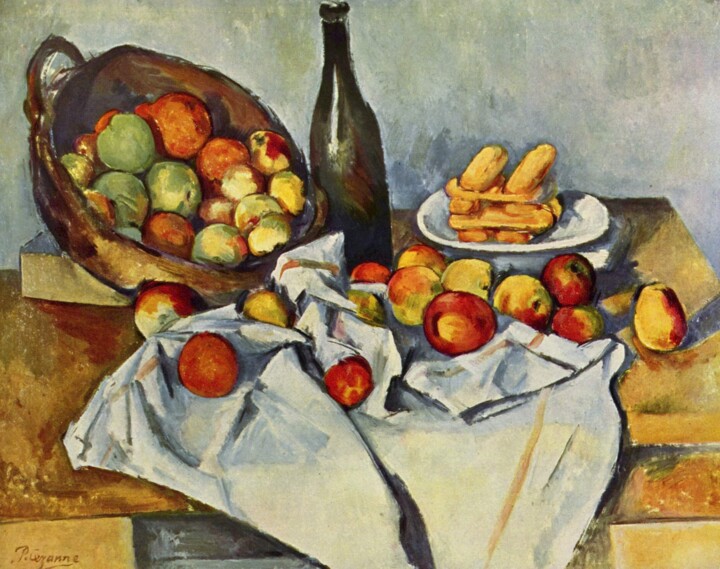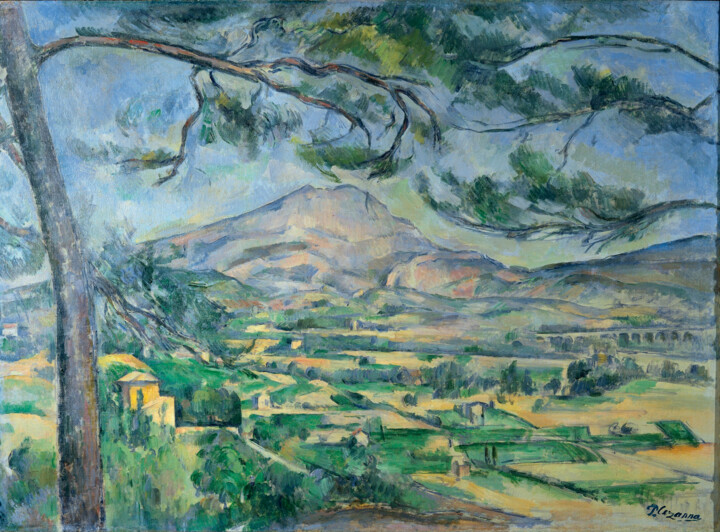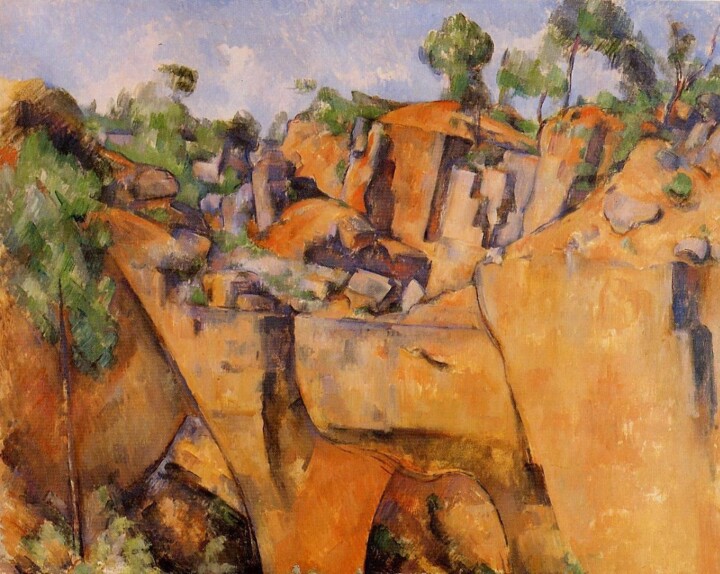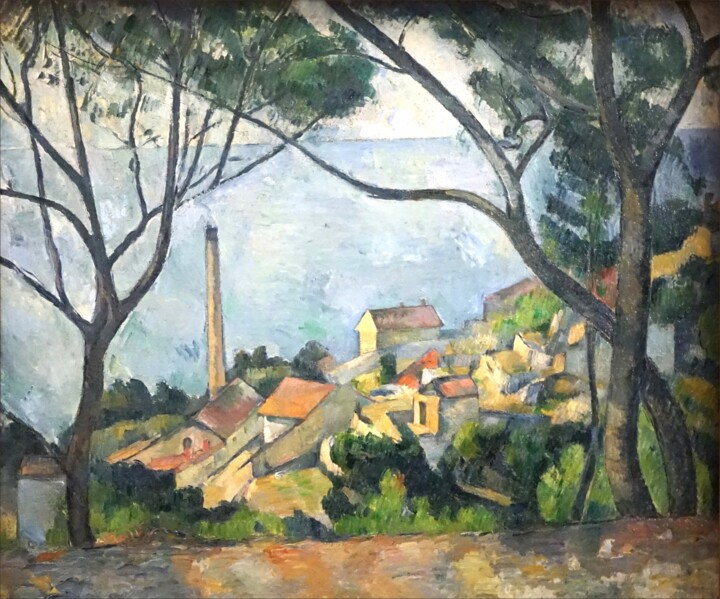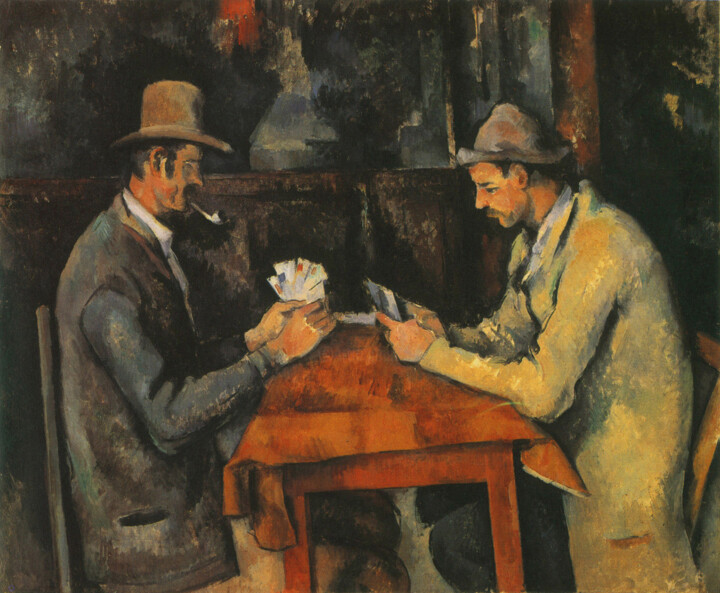 Paul Cézanne, Self-portrait, 1888-1890. Oil on canvas, 44×36 cm. Ny Carlsberg Glyptotek: Copenhagen.
Paul Cézanne, Self-portrait, 1888-1890. Oil on canvas, 44×36 cm. Ny Carlsberg Glyptotek: Copenhagen.
Who was Paul Cézanne?
Paul Cézanne, born in Aix-en-Provence in 1839 and died in 1906, was part of the post-Impressionist movement and laid the groundwork for many avant-garde movements of the 20th century, especially in terms of formal simplification. Cézanne was not easygoing and had a strained relationship with his father who wanted him to be a lawyer instead of an artist. He rebelled and pursued his passion for art. He had few close friends, but artist Camille Pissarro was one of them, and they had a long and productive artistic relationship. However, writer Émile Zola was not so lucky and was criticized harshly by Cézanne after publishing one of his novels. Although Cézanne frequented the Café Guerbois with the Impressionists in Paris, he soon developed a personal style that reflected a more scientific and reflective approach to painting. He believed that art should have its legitimate autonomy. Cézanne spent most of his life in the French countryside of Provence, where he found inspiration for many of his iconic works, such as the mountain of Sainte-Victoire, still lifes, and portraits. Although he was attracted to Parisian city life during his youth, he preferred the rural setting of his home later in life.
 Paul Cézanne, A Modern Olympia, 1888-1890. Oil on canvas, 46×55 cm. Paris: Musée d'Orsay.
Paul Cézanne, A Modern Olympia, 1888-1890. Oil on canvas, 46×55 cm. Paris: Musée d'Orsay.
5 key concepts
1. Form and Color: Cézanne considered form and color to be equally important in his compositions, and he sought to create a new, subjective pictorial reality that went beyond mere imitation of nature.
2.Simplification: Cézanne's work is characterized by a simplification of forms and a reduction of objects to their basic geometric shapes. He believed that this simplification was necessary to reveal the underlying essence of his subjects.
3.Influence on Modern Art: Cézanne's innovative approach to painting had a significant impact on modern art movements such as Cubism, Fauvism, and Abstract Expressionism.
4.Still Life and Landscape: Cézanne's favorite subjects were still lifes and landscapes, and he frequently depicted objects from his everyday surroundings in a unique and unconventional way.
5. Personal Life: Cézanne was known for his reclusive personality and difficult relationships with his family and friends. However, he maintained close artistic relationships with other artists such as Camille Pissarro and Émile Zola, who were influential in his development as an artist.
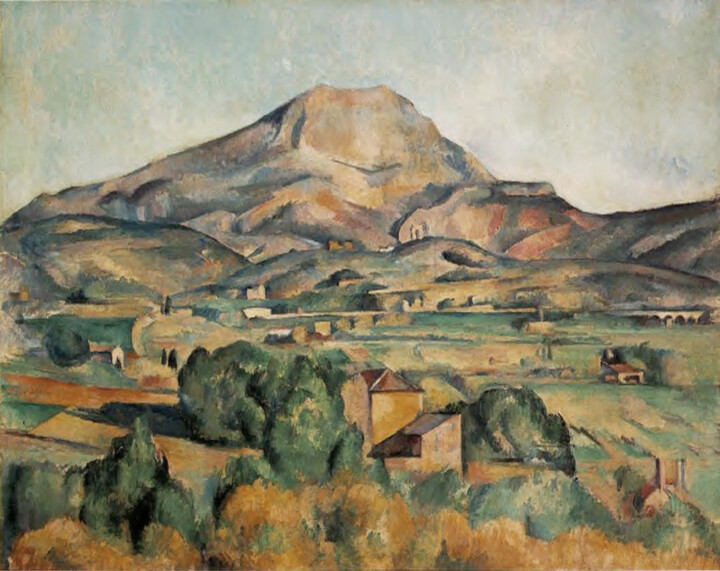 Paul Cézanne, Mont Sainte-Victoire seen from Bellevue, c. 1895. Oil on canvas, 73 cm × 92 cm. Pennsylvania: Barnes Foundation.
Paul Cézanne, Mont Sainte-Victoire seen from Bellevue, c. 1895. Oil on canvas, 73 cm × 92 cm. Pennsylvania: Barnes Foundation.
Style
In his early years, Paul Cézanne's heavy brush strokes and thickly layered paint created a tangible texture, and his brush marks were clearly visible. This "violent" style changed when he met Camille Pissarro and began painting outside from nature. His style became more structured, and his colors became brighter, but his brushstrokes remained thick. In the late 1870s, Cézanne's compositions became smoother, and he focused on creating form using his paintbrush, inspired by Monet. However, he often left his works incomplete, taking months to finish a piece. He used an analytical method of building upon each previous figure with a new outline, taking months to finish portraits or still lifes. Cézanne's method was so complicated that he couldn't use real flowers because they would wilt before he finished his painting. Although he used drawings and sketches, much of the work was done on the canvas itself. He found working from nature to be challenging and often returned to the same subject matter multiple times.
In the 1870s, Paul Cézanne was influenced by Impressionism and was drawn to the group's rejection of the Salon jury. While not an Impressionist himself, Cézanne's association with artists such as Camille Pissarro and Claude Monet led to a brighter color palette and painting en plein air. However, Cézanne eventually distanced himself from the group due to artistic differences. Pissarro remained a significant influence on Cézanne and encouraged him to work outdoors with a wider range of colors. Cézanne's brushstrokes became more fluid and less dense, revealing a shift towards Impressionism. Nonetheless, he maintained an interest in indoor subjects, particularly still-life paintings of flowers. Later, in the late 1870s, Cézanne moved away from Impressionism and adopted a style that was characterized by heavy and dark colors. He wanted to analyze nature rather than simply copy its surface beauty, which was reflected in his paintings. Throughout his life, Cézanne's love of nature and his home in Aix-en-Provence influenced his work as he sought to capture the constant aspects of nature rather than its transient beauty.
Subjects
Paul Cézanne's impact on modern art is considerable, even though his choice of subjects was often traditional, including fruits, still lifes, portraits, and landscapes. He is known for his innovative style, particularly in the area of still-life painting, which became increasingly significant in his work from the 1880s. His still-life paintings are regarded as some of his most significant artistic accomplishments and had a profound influence on the stylistic developments of early 20th-century art.
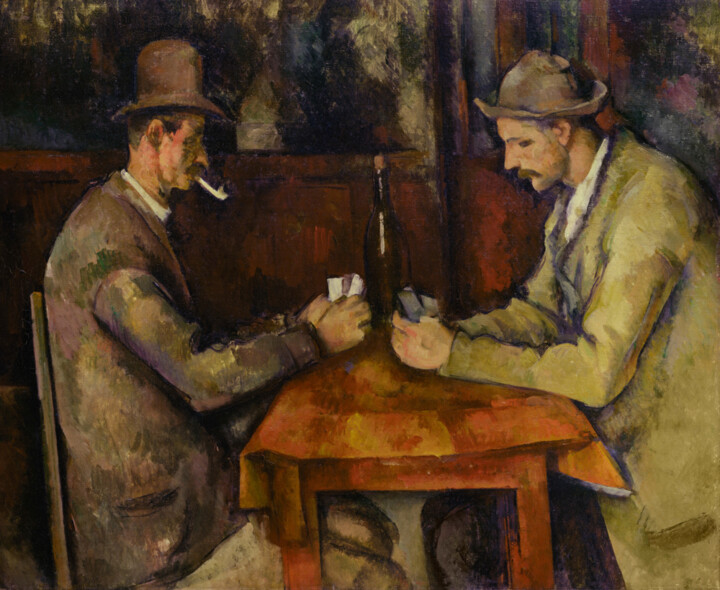 Paul Cézanne, The Card Players, 1894–95. Oil on canvas, 47.5 cm × 57 cm. Paris: Musée d'Orsay.
Paul Cézanne, The Card Players, 1894–95. Oil on canvas, 47.5 cm × 57 cm. Paris: Musée d'Orsay.
The Card Players (1890-95)
The two individuals participating in the card game are positioned separately from the rest of the club's patrons. These men could possibly be peasants, and it is likely that one of them was named Alexandre, who served as the gardener at the artist's father's estate in Jas de Bouffan. They are seated at a modest wooden table, which holds a bottle of wine sealed with a cork. The Card Players are attired in unassuming yet respectable clothing. The gentleman seated on the left wears both a jacket and a hat. As he carefully examines his cards, he smokes from a pipe. On the other hand, the player on the right appears younger and dresses in a more casual manner. Surrounding them, one can observe the room's wooden wall decorations known as boiserie, as well as a glass door.
The painting "Card Players" by Paul Cézanne has been part of various art collections throughout its history. It was initially included in the collection of Ambroise Vollard, then passed on to the Denys Cochin collection and later became part of the Durand-Ruel collection. Finally, until 1911, it found its place in the collection of Count Isaac de Camondo in Paris. After that, it was bequeathed by the Count to the State Museums and eventually ended up in the Louvre Museum. From 1947 to 1986, it was exhibited at the Galerie du Jeu de Paume in Paris and later moved to the Musée d'Orsay in 1986, where it is currently displayed. Paul Cézanne created five paintings with the same theme of card players. The version exhibited at the Musée d'Orsay is particularly noteworthy as it showcases the remarkable outcomes of the artist's research and experimentation. Interestingly, a work titled "The Card Players" by the Le Nain brothers was exhibited in the museum in Aix-en-Provence. It is possible that Cézanne drew inspiration from this piece when creating his own paintings in the series.
The artwork created between 1894 and 1895 is a remarkable piece belonging to the series of oil paintings of card players by the post-Impressionist master, Cézanne. These paintings were produced during the final period of Cézanne's career, specifically in the early 1890s, and the series consists of five unique works. Each version differs in terms of size, the number of players depicted, and the setting of the card game. In preparation for The Card Players series, Cézanne extensively created numerous drawings and studies. Notably, one of the versions from The Card Players series was sold in 2011 to the royal family of Qatar for an estimated price of $250 million (equivalent to $301.1 million today), setting a new record for the highest price ever paid for a painting. This record was only surpassed in November 2017.
The style
Paul Cézanne employed geometric simplification when constructing the figures in the scene. The left player's hat, arms, and torso are reduced to cylindrical shapes, while the small table is depicted as a simplified parallelepiped. The relationships between the limbs are also transformed into geometric patterns, with the flexed arms forming triangles. Cézanne's primary focus was the analysis of real forms and their depiction through simplification, which is why his approach is referred to as Post-Impressionist. His working method was entirely rational, as he was not concerned with narrating an event or expressing a particular state of mind. These research pursuits greatly influenced the development of Cubism. Cézanne's brushstrokes are broad and regular, creating a sculptural effect that emphasizes the geometric simplification of the figures and their primary masses. The modeling technique employed is synthetic and highlights the geometric simplification of forms.
Color and lighting
Paul Cézanne's painting "Card Players" exhibits a balanced color scheme, utilizing both warm and cool colors. The two players and their surrounding environment are depicted in cool hues such as blue, green, and gray. In contrast, the coffee table, hands, faces, and woodwork are painted in warm tones of pink, orange, and brown. This creates a main contrast of complementary colors, with a tendency towards blue and orange. To enhance the focal points, there is an additional contrast of brightness, particularly noticeable on the face and jacket of the player on the right. The overall color composition of the painting achieves a harmonious interplay between warm and cool tones, establishing a visual balance.
The space
The coffee table painted at the center of the artwork plays a crucial role in creating a sense of three-dimensional space through its use of perspective. The table's perspective lines establish depth and help structure the spatial arrangement. Moreover, the overlapping perspectives contribute to the proper representation of the players and their interaction across the table. The contrast in lighting between the figures and the background also influences the construction of the spatial composition, emphasizing the relationship between the elements and enhancing the perception of space.
The composition and framing
Cézanne's painting "Card Players" adopts an almost square format, which contributes to the arrangement of a central symmetry along the vertical axis. The positioning of the two hands, approaching each other at the center, creates a sense of symmetry. The arms and bodies are then mirrored with slight variations in their positions. The small table is also depicted frontally, enhancing the image's overall stability. The background is characterized by the paneling and glass elements, providing a clean and organized backdrop. As a result, the painting evokes a sense of stability, stillness, and suspended time. Additionally, the figures assume a monumental quality, thanks to the solid representation of forms and the understated composition.
Insights
Like many other artists in Paris, Paul Cézanne would often visit bistros. These establishments served as vibrant hubs of social and cultural life in the city. Customers would gather around the tables, engaging in activities such as drinking, smoking, and playing cards. In the midst of the atmosphere, heightened by the presence of tobacco smoke and alcohol, significant conversations, singing, dancing, and occasionally even intense fights would unfold.
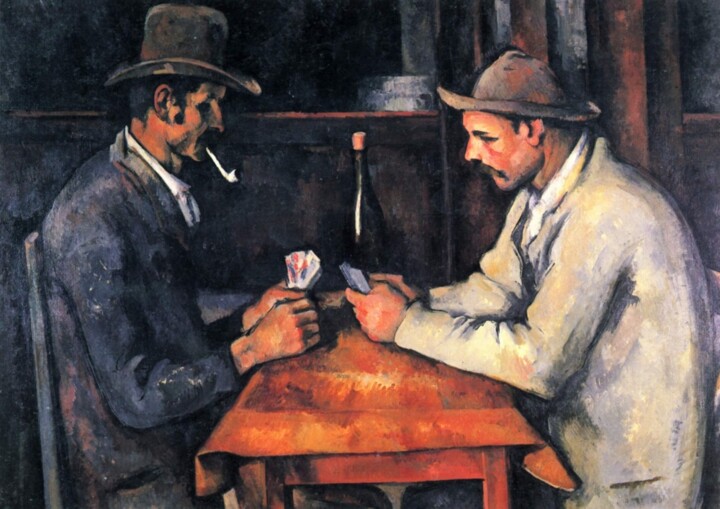 Paul Cézanne, The Card Players, 1892–93. Oil on canvas, 97 × 130 cm, Private collection.
Paul Cézanne, The Card Players, 1892–93. Oil on canvas, 97 × 130 cm, Private collection.
The serie
Art critics consider the series of paintings by Cézanne to be a fundamental aspect of his artistic development during the early to mid-1890s. These works are also seen as a precursor to his later years, where he produced some of his most acclaimed masterpieces.Each painting in the series portrays peasants from the Provençal region engrossed in their card games and smoking pipes. The subjects, exclusively male, are depicted with a serious and focused demeanor, their eyes fixed on the game before them. Cézanne drew inspiration from 17th-century Dutch and French genre paintings, which often depicted lively card games in taverns with rowdy and drunken gamblers. However, Cézanne opted for a different approach, replacing the boisterous characters with solemn tradesmen in simplified settings. Unlike the dramatic and narrative-driven compositions of the genre's previous paintings, Cézanne's portraits are characterized by their lack of dramatic elements, storytelling, and traditional characterizations. In contrast to the 17th-century genre, Cézanne's works notably exclude the prominent elements of alcohol and money, except for an unused wine bottle present in the two-player versions. The models for Cézanne's paintings were local farm laborers, some of whom worked on the Cézanne family estate, known as the Jas de Bouffan. Each scene captures a moment of tranquil concentration, with the men directing their gaze downward at their cards rather than at each other. The cards themselves serve as their primary means of communication outside of their work duties. One critic described these scenes as "human still life," while another speculated that the intense focus displayed by the card players mirrors the artist's own absorption in his art.
Paintings
Cézanne created a total of five paintings depicting card players, but the last three paintings share similar compositions and feature two players. Because of this similarity, they are sometimes considered as a single version. The exact dates of these paintings are uncertain, but it has been traditionally believed that Cézanne started with larger canvases and gradually reduced the size in subsequent versions. However, recent research has questioned this assumption, introducing doubts about the chronological order of the paintings. The largest version of the card players painting, created between 1890 and 1892, is a composition of great complexity. It occupies a canvas measuring 134.6 x 180.3 cm (53 x 71 inches) and showcases five figures. In the foreground, there are three card players seated in a semi-circle around a table, accompanied by two spectators positioned behind them. On the right side of the painting, seated behind the second player and to the right of the third player, is a boy whose gaze is directed downward, attentively observing the game. Towards the back, on the left side between the first and second player, stands a man leaning against the wall, smoking a pipe, and seemingly waiting for his turn to join the table. It has been suggested that Cézanne included the standing man to add depth to the painting and draw attention to the upper portion of the canvas.
Similar to the other versions, this painting presents a restrained narrative featuring peasant men dressed in loose-fitting garments and assuming natural postures, entirely absorbed in their card game. Writer Nicholas Wadley referred to a "tension in opposites," where contrasting elements such as shifts in color, interplay of light and shadow, hat shapes, and folds of clothing create a story of conflict through opposition. Some have described a sense of "alienation" depicted in the series, which is most evident in this particular version. Currently, the painting is owned and displayed at the Barnes Foundation museum in Philadelphia, Pennsylvania. The Metropolitan Museum of Art in New York houses a more compact version of the painting, which was long believed to be the second iteration of The Card Players series. Measuring 65.4 x 81.9 cm (25 3/4 x 32 1/4 in), it is less than half the size of the Barnes painting. In this rendition, the composition remains mostly unchanged, except for the absence of the boy. The viewers' perspective is slightly closer to the game, and the spacing between the figures is reduced. Unlike the previous painting, all the men in this version are depicted wearing hats. Additionally, the left shelf with a vase and the lower half of a picture frame in the center of the wall have been omitted, leaving only the four pipes and a hanging cloth behind the card players.
 Paul Cézanne, Man with the Pipe, c. 1890. Oil on canvas, 90 × 72 cm. Hermitage Museum, St. Petersburg.
Paul Cézanne, Man with the Pipe, c. 1890. Oil on canvas, 90 × 72 cm. Hermitage Museum, St. Petersburg.
The painting features a brighter color palette, with less emphasis on blue tones compared to the larger version. X-ray and infrared studies conducted on this version of The Card Players have revealed layers of preliminary graphite underdrawing, indicating Cézanne's speculative planning process. It also shows extensive layers of worked oil paint, suggesting that this version might have served as the preliminary work for Cézanne's two largest versions of the series, challenging the historical belief that it was the second version. The underdrawing further indicates that Cézanne faced challenges in transferring the individual figures, previously painted in separate studies, onto a single canvas. In the final three versions of The Card Players, Cézanne is believed to have resolved the "spatial conundrum" by eliminating spectators and unnecessary details, focusing only on the essential elements: two players engrossed in their game. The composition of the scene is described as balanced yet asymmetrical, with a natural symmetry between the two players who become each other's counterparts in a deliberate opposition. The man on the left, dressed in darker and more formal attire, is depicted smoking a pipe and wearing a top hat with a brim cast downwards, while the man on the right, in lighter and loosely fitted clothing, is without a pipe and wears a hat with an upturned brim, leaning over the table. Even the cards they hold display contrasting light and dark tones.
In each of the two-player paintings, a solitary wine bottle is positioned in the middle of the table, symbolizing both a dividing line between the two participants and the center of the painting's symmetrical balance. Among the three versions, the most renowned and frequently reproduced is housed in the Musée d'Orsay in Paris. This painting is also the smallest, measuring 47.5 x 57 cm (17 3/4 x 22 1/2 in). Art historian Meyer Schapiro described it as the "most monumental and refined" of the versions, featuring simpler yet more diverse relationships between shapes. It is sparsely painted and generally regarded as the concluding piece of The Card Players series. The scene undergoes a shift in perspective, with the player on the left being more prominently positioned within the frame, including his chair, creating the illusion of proximity. In contrast, the partner on the right is partially cut off from the scene, obscuring his back, while the table is presented at an angle. Critics have observed a "restrained deception" in Cézanne's use of color.
Solid forms are rendered with thinly applied, graduated layers of "priming" color to convey structure, while touches of lilac and green enliven the canvas. The lower half of the painting features bright, deep colors for the tablecloth. This particular version of The Card Players was involved in a notable theft in August 1961, when eight Cézanne paintings were stolen from a traveling exhibition in Aix. The stolen work, The Card Players, became the subject of a four-color postage stamp issued by the French government to acknowledge the loss. Fortunately, all the paintings were recovered several months later after a ransom was paid. The other two-player paintings can be found in the Courtauld Institute of Art in London and in a private collection. In February 2012, Vanity Fair reported that the royal family of Qatar had acquired their own version of the painting in 2011, from the private collection of Greek shipping magnate George Embiricos, for a record-breaking price estimated between $250 million and $320 million.
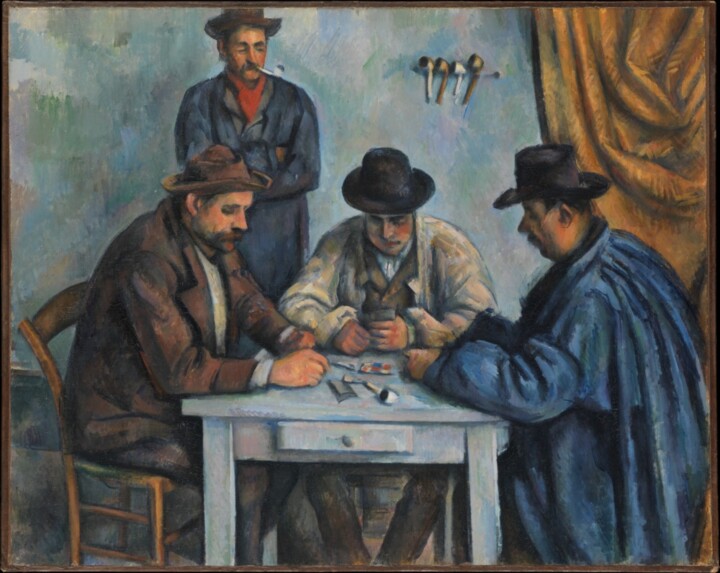 Paul Cézanne, The Card Players, 1890–1892. Metropolitan Museum of Art, New York.
Paul Cézanne, The Card Players, 1890–1892. Metropolitan Museum of Art, New York.
1890–92 version
In his fifties, Cézanne embarked on a painting project centered around capturing the essence of a subject that had previously inspired esteemed artists such as Caravaggio and Chardin. Right from the beginning, he was resolute in making it uniquely his own, as evident in this robust Provençal scene. Cézanne meticulously constructed this composition based on studies he had made of local farm workers. Once he had deciphered his vision, he continued to refine the postures and positions of the card players until they, much like the four pipes hanging on the wall behind them, fit perfectly into place. The sense of quiet authority that Cézanne achieved here served as the foundation for a larger version of the artwork (located in the Barnes Foundation in Philadelphia), and he further explored the series by creating three additional pieces where he eliminated unnecessary details to focus solely on a pair of players.
Colors
In Paul Cézanne's painting "The Card Players," a range of earthy colors can be observed. Two of the men seated at the table are depicted in shades of brown and cream, creating a warm and natural palette. This color scheme is juxtaposed by the deeper blue hue of the jacket worn by the man seated on the right, adding a contrasting element to the composition. Similarly, the standing man near the wall is also dressed in a deeper blue jacket, possibly accompanied by a red cravat, which introduces a subtle contrast against the more neutral tones present in the painting. The wall in the painting exhibits a range of colors, including lighter shades of green, blue, and hints of pink and gray. This colorful wall serves as a contrasting backdrop to the deeper yellow or bronze-gold curtain on the right side. The light blue color of the table subtly resonates with the hue of the wall, creating a visual connection. Moreover, the colors of blue, red, and white are also reflected in the card placed at the center of the table, adding a harmonious repetition of these hues throughout the composition.
Texture, shape and form
Paul Cézanne's brushwork in "The Card Players" is palpable on the canvas, with areas where the paint appears thickly applied. The brushstrokes exhibit a sense of spontaneity, with some being short and choppy, while others are longer, even, and smoother. The painting represents naturalistic and organic forms, depicting recognizable objects from the real world such as human figures, a table, a curtain, hats, smoking pipes, and chairs. One intriguing aspect of Cézanne's artistic approach, for which he is renowned, is his exploration of geometric compositions. "The Card Players" showcases a variety of lines, many of which are created by the visible brushstrokes. For instance, the folds on the men's jackets, particularly the pronounced patterned lines on the man seated to the right, the folds on the right-side curtains, and the diagonal lines on the curtains, contribute to the creation of patterns within the composition.
Space
Paul Cézanne's arrangement of space in "The Card Players" portrays the scene as if we, the viewers, are observing the card game from a short distance away, with a slightly angled perspective from the right. The composition creates a sense of depth through the placement of the figures. For instance, the two figures seated at the ends of the table establish a layering effect for the figure in the middle. This sense of depth is further enhanced by the presence of a figure in the background. The spatial depth of the background is somewhat ambiguous, especially noticeable with the man near the wall. It is unclear whether he is leaning against the wall or standing with some space between himself and the wall. However, the visibility of the floor and skirting on the left side provides a point of reference, allowing us to gauge the man's distance from our perspective.
Studies and sketches
Cézanne dedicated significant effort to creating numerous studies and preparatory drawings for The Card Players series. It was previously believed that he started the series by working on the larger paintings first and then moved on to smaller versions. However, modern x-ray analysis of the paintings, along with further examination of preparatory sketches and studies, has led some scholars to propose that Cézanne used both the studies and the smaller versions to prepare for the larger canvases. In preparation for the final paintings, Cézanne made over a dozen initial sketches and painted studies of local farmworkers. It is speculated that the models posed for these studies rather than the completed works themselves, and it is possible that the artist sketched preliminary work in a café in Aix. Some of these studies are highly regarded as independent pieces of art, with particular attention given to the accompanying work titled "Man with a Pipe," which is displayed alongside The Card Players at the Courtauld Gallery in London. Along with two similar paintings of smokers created during the same period, these studies are considered by many as some of Cézanne's most exceptional portraits.
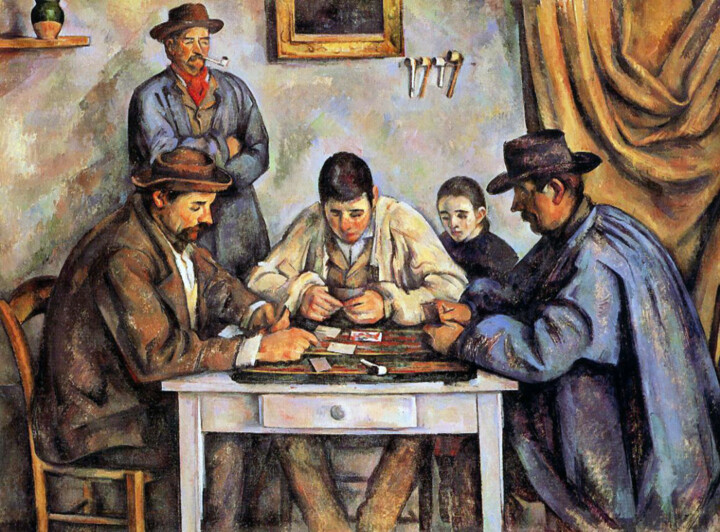 Paul Cézanne, The Card Players, 1890–1892. Barnes Foundation, Philadelphia, Pennsylvania.
Paul Cézanne, The Card Players, 1890–1892. Barnes Foundation, Philadelphia, Pennsylvania.
Far from Impressionism
The theme of patrons in a bar or tavern, seen in Cézanne's painting, is often associated with Impressionism, evoking works by artists like Manet, particularly "The Bar at the Folies-Bergère," Renoir, and Degas. However, Cézanne's approach diverges significantly from the typical Impressionist style. Unlike his Impressionist counterparts, Cézanne's intention is not to depict a specific moment or capture a fleeting impression. Instead, he aims to create a cohesive form, a synthesis of the scene that leaves a lasting impression in the viewer's mind, almost frozen by the power of memory. His artistic quest goes beyond mere visual impressions, seeking to reveal an essential truth that cannot be captured through direct observation alone. As the artist himself stated, "In painting, there are two factors: the eye and the brain, and both must be understood. One must work on their mutual development: the eye for perceiving nature, and the brain for logically organizing the sensations that precede the means of expression." Cézanne's ambition lies in the combination of visual perception and intellectual interpretation, allowing the viewer to engage with a deeper understanding of the subject matter.
Discovering the essence of reality
Cézanne communicated to his friend and colleague Émile Bernard the belief that an artist should approach nature by considering the forms of the cylinder, sphere, and cone. He held the view that perceiving nature solely through the senses was not sufficient to capture its true essence. According to Cézanne's artistic philosophy, the intellect should also play a role in investigating and understanding the world. He believed that beneath the intricate and elusive appearances of things, there exist timeless and transcendent archetypes, serving as eternal models that artists have the responsibility to unveil. Geometry, with its pervasive presence, becomes the key to unlocking this truth. By reintroducing geometry into their artistic approach, painters could imbue their figures with greater monumentality and essential forms. Color, too, was employed with a constructive purpose, defining planes, changes in perspective, edges, curves, and variations in light. Cézanne's methodology, based on these principles, had far-reaching consequences for the development of the later Cubist movement.
Exhibitions
A collaborative exhibition was organized by the Courtauld Gallery in London and the Metropolitan Museum of Art in New York in 2010-2011. The exhibition showcased The Card Players paintings, along with early studies, sketches, and related artworks. It was held in London from October 21, 2010, to January 16, 2011, and in New York from February 9, 2011, to May 8, 2011. This exhibition was significant as it marked the first-ever dedicated showcase of the series, featuring the largest collection of Cézanne's Card Players paintings displayed together. The exhibition included artworks owned by the Courtauld, Metropolitan, and Musée d'Orsay. However, the versions held by the Barnes Foundation and a private collection were presented as prints since the Barnes Foundation does not lend its artworks, and the private collector declined to release the work for display. In addition to The Card Players series, the exhibition also featured a mini-series known as The Smokers, which included more than a dozen other studies and sketches. Unfortunately, a legal dispute prevented the version of "Man with a Pipe" from the Hermitage Museum from being exhibited in New York.

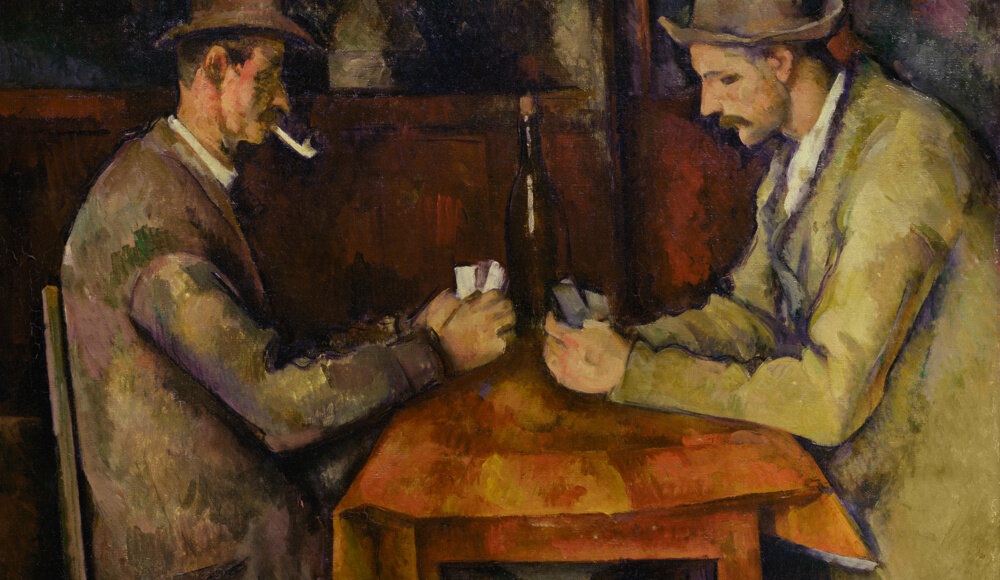
 Selena Mattei
Selena Mattei

